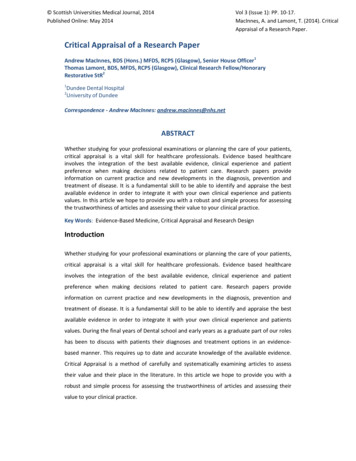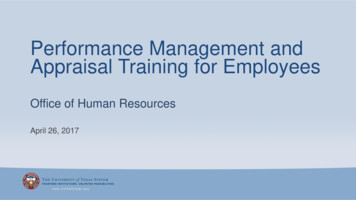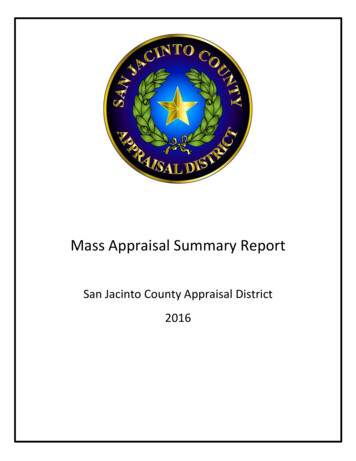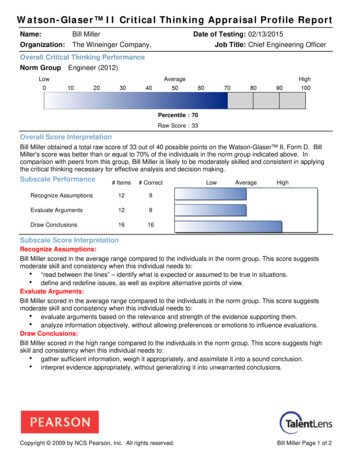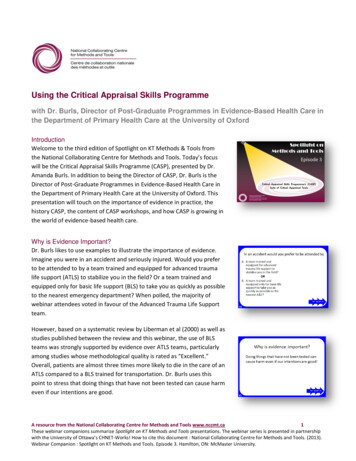
Transcription
Using the Critical Appraisal Skills Programmewith Dr. Burls, Director of Post-Graduate Programmes in Evidence-Based Health Care inthe Department of Primary Health Care at the University of OxfordIntroductionWelcome to the third edition of Spotlight on KT Methods & Tools fromthe National Collaborating Centre for Methods and Tools. Today’s focuswill be the Critical Appraisal Skills Programme (CASP), presented by Dr.Amanda Burls. In addition to being the Director of CASP, Dr. Burls is theDirector of Post-Graduate Programmes in Evidence-Based Health Care inthe Department of Primary Health Care at the University of Oxford. Thispresentation will touch on the importance of evidence in practice, thehistory CASP, the content of CASP workshops, and how CASP is growing inthe world of evidence-based health care.Why is Evidence Important?Dr. Burls likes to use examples to illustrate the importance of evidence.Imagine you were in an accident and seriously injured. Would you preferto be attended to by a team trained and equipped for advanced traumalife support (ATLS) to stabilize you in the field? Or a team trained andequipped only for basic life support (BLS) to take you as quickly as possibleto the nearest emergency department? When polled, the majority ofwebinar attendees voted in favour of the Advanced Trauma Life Supportteam.However, based on a systematic review by Liberman et al (2000) as well asstudies published between the review and this webinar, the use of BLSteams was strongly supported by evidence over ATLS teams, particularlyamong studies whose methodological quality is rated as “Excellent.”Overall, patients are almost three times more likely to die in the care of anATLS compared to a BLS trained for transportation. Dr. Burls uses thispoint to stress that doing things that have not been tested can cause harmeven if our intentions are good.A resource from the National Collaborating Centre for Methods and Tools www.nccmt.ca1These webinar companions summarize Spotlight on KT Methods and Tools presentations. The webinar series is presented in partnershipwith the University of Ottawa’s CHNET-Works! How to cite this document : National Collaborating Centre for Methods and Tools. (2013).Webinar Companion : Spotlight on KT Methods and Tools. Episode 3. Hamilton, ON: McMaster University.
Establishment of CASPThe primary impetus for the Critical Assessment Skills Programme(CASP) was the Getting Research into Practice Project in the 1980s,which was a response to clinicians using interventions that were eithercontradicted or not supported by evidence. This project identified a lackof appreciation among managers and policy makers for the importanceof using research evidence to inform decisions, which led to thedevelopment of educational workshops to address this need. Theseworkshops soon developed into CASP.The CASP workshops were initially geared toward simply raisingawareness of the need for evidence in practice. However, they haveevolved to focus on the importance of systematic reviews in evidencebased practice, characteristics of a high-quality review, interpretation ofresults, and how to locate systematic reviews efficiently. The key themeparticipants walk away with is that systematic reviews are decisionmakers’ best resource for research evidence, and other forms ofevidence should only be used in the absence of a high-qualitysystematic review.The CASP WorkshopsThe philosophy of CASP workshops is that they should bemultidisciplinary, problem-based, enjoyable, interactive, and smallgroup-oriented with high quality and accessible materials. The CASPteam aims to provide a safe environment where people feel they canexpress themselves. Rather than train future epidemiologists, CASPworks to give everyone the skills to make important decisions. CASPreinforces the lesson that, in evidence-based practice, it is expectedthat you build on the experience of others and admit uncertainty whenyou are unsure.During each workshop, participants appraise a research paper with anaccompanying CASP checklist. Workshops typically consist of fewer than25 people and are a half-day in length. The small number of participantsand short time frame help workshops be interactive rather thandidactic, allowing participants to work in groups in a problem-basedlearning environment to appraise a paper together. In abstaining fromlecture-style teaching in favour of small-group facilitation, Dr. Burlsfinds that CASP workshops allow participants to pool theirunderstanding to form the same conclusions as would be taught in alecture, but in a much more enjoyable and enduring learning experience.A resource from the National Collaborating Centre for Methods and Tools www.nccmt.ca2These webinar companions summarize Spotlight on KT Methods and Tools presentations. The webinar series is presented in partnershipwith the University of Ottawa’s CHNET-Works! How to cite this document : National Collaborating Centre for Methods and Tools. (2013).Webinar Companion : Spotlight on KT Methods and Tools. Episode 3. Hamilton, ON: McMaster University.
The CASP ChecklistThe central tenet of the CASP checklists is that they should besufficiently accessible that they can be used without training. To ensurethis, the structure is held consistent between all checklists. Eachchecklist asks three questions:1.2.3.Are the results valid?What are the results?Are the results relevant to the local context?CASP Checklist: ValidityThe validity questions of the checklist vary depending on what criteriaare most relevant to a given study design, and what biases each studydesign is prone to. However, each set of validity questions involvescertain screening questions to determine whether the study was clear inits focus, and whether the study meets the essential requirements forvalidity. Given the finite limit of available time in public health practice,the purpose of these questions is to show practitioners if a study is worthpursuing based on whether it earns a “Yes” for these questions.CASP Checklist: ResultsIn the results section, the checklist asks: What are the results? What isthe absolute bottom line? Did the intervention work, or not? Dr. Burlsexpresses that often results are relayed in terms of relative risk, and thisis not always helpful for conceptualizing outcomes. CASP encouragesparticipants to express results in terms of absolute risk - such as numberneeded to treat - with the goal of understanding how precise the resultsare, and how much uncertainty there is around them.CASP Checklist: RelevanceThe third section of the checklist requires a critical understanding of yourown context and the study results to assess external validity. This sectionasks whether the results of the study can be applied to the localpopulation. Additionally, users are asked to consider whether all clinicallyimportant outcomes were considered, as many internally valid studiesmay neglect to report on relevant and important outcomes. Finally, thechecklist asks whether the benefits outweigh the harms and costs, whichis an essential consideration in public health.A resource from the National Collaborating Centre for Methods and Tools www.nccmt.ca3These webinar companions summarize Spotlight on KT Methods and Tools presentations. The webinar series is presented in partnershipwith the University of Ottawa’s CHNET-Works! How to cite this document : National Collaborating Centre for Methods and Tools. (2013).Webinar Companion : Spotlight on KT Methods and Tools. Episode 3. Hamilton, ON: McMaster University.
Learning about Randomized Controlled TrialsPart of helping participants appraise research includes developing an understanding of what qualities lead tohigh-quality research. In order to do this CASP facilitators start with a question, such as “Do ‘friendly bacteria’help problem tummies?” From here, participants design a hypothetical study to answer this question. Thetypical starting point is to apply a hypothetical intervention to a population and observe an outcome. From here,facilitators help to refine the idea by suggesting, “Let’s imagine we apply the intervention and we see results. Isthere any other reason why they might see results that was not due to the intervention?”In practicing critical thinking around research design, participantsrespond to this question by refining their research design. Ultimately,facilitators pose the question, “How could you design a study to minimizethe chance of being fooled into thinking an intervention is effective (orharmful), when the changes observed would simply have happenedanyway?” Invariably, participants eventually arrive at the concept of adouble-blind, placebo controlled, randomized trial. This process givesparticipants an appreciation of the importance of methodological rigour.Learning about Systematic ReviewsCASP facilitators take a similar approach to discuss the rigour ofsystematic reviews. In returning to the example of probiotic yogurt, Dr.Burls recounts her experience as a participant in a trial involvingprobiotic yogurt. In this study, the publication of negative results wasdelayed at the request of Danone , who funded the research. Throughthis and other examples, participants rapidly develop an understandingof the concept of publication bias.Participants often struggle with what is meant by heterogeneity as itrelates to whether it is appropriate to combine results. Facilitators usethe slide to the right to illustrate the point that when combining results, itneeds to be logical to do so. Through the use of humour and tangibleexamples, CASP makes concepts of evidence-based practice bothmemorable and accessible to participants, and in doing so improves theircomfort and skill with using evidence to inform decision making.CASP International NetworkIn addition to providing training for critical appraisal, CASP also offersparticipants the opportunity to become CASP facilitators as well. Whatbegan as a capacity-building initiative on the local scale has grown to aninternational presence for CASP. Requests from countries such as Spain,Norway, and the UK facilitated the creation of the CASP InternationalNetwork, which provides annual training for volunteers and allows CASPto continue to educate practitioners around the globe. Currently, CASPA resource from the National Collaborating Centre for Methods and Tools www.nccmt.ca4These webinar companions summarize Spotlight on KT Methods and Tools presentations. The webinar series is presented in partnershipwith the University of Ottawa’s CHNET-Works! How to cite this document : National Collaborating Centre for Methods and Tools. (2013).Webinar Companion : Spotlight on KT Methods and Tools. Episode 3. Hamilton, ON: McMaster University.
runs workshops to help organizations prepare their own training in future.Additionally, CASP now offers online modules about critical appraisal andfinding evidence that guide health care professionals through appraisals at theirown pace.A resource from the National Collaborating Centre for Methods and Tools www.nccmt.ca5These webinar companions summarize Spotlight on KT Methods and Tools presentations. The webinar series is presented in partnershipwith the University of Ottawa’s CHNET-Works! How to cite this document : National Collaborating Centre for Methods and Tools. (2013).Webinar Companion : Spotlight on KT Methods and Tools. Episode 3. Hamilton, ON: McMaster University.
will be the Critical Appraisal Skills Programme (CASP), presented by Dr. Amanda Burls. In addition to being the Director of CASP, Dr. Burls is the . are most relevant to a given study design, and what biases each study design is prone to. However, each set of validity questions involves . finding evidence that guide health care .

